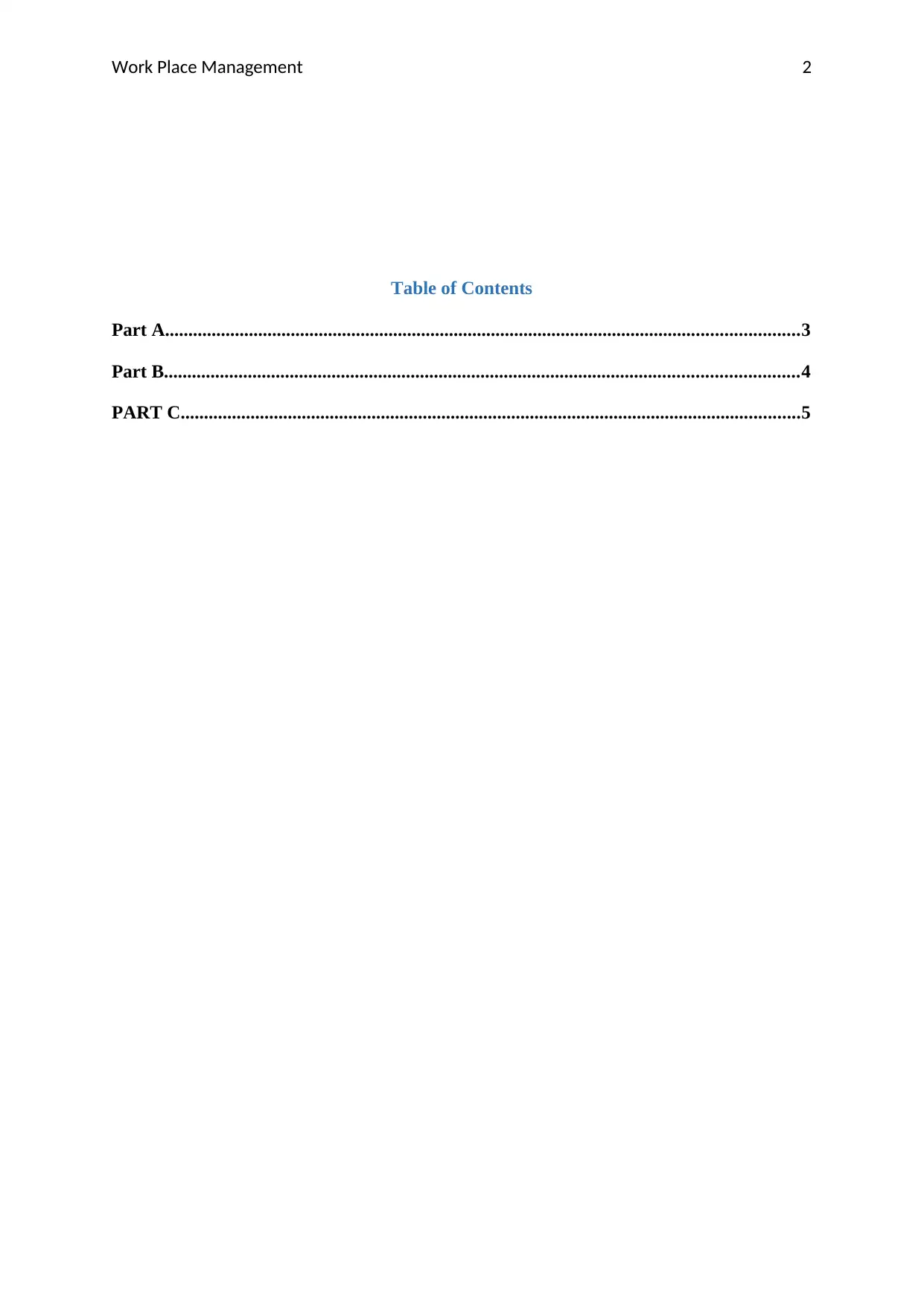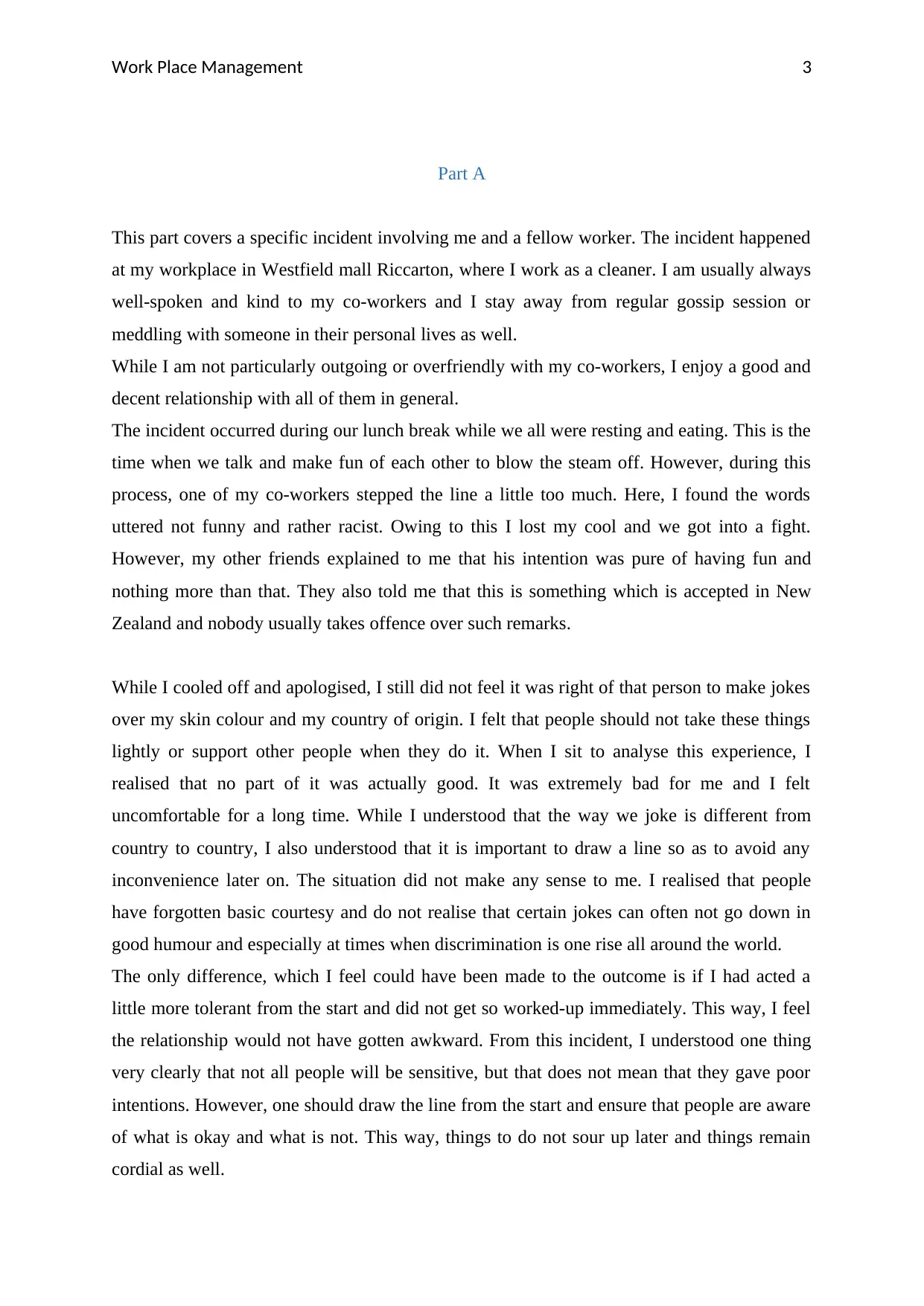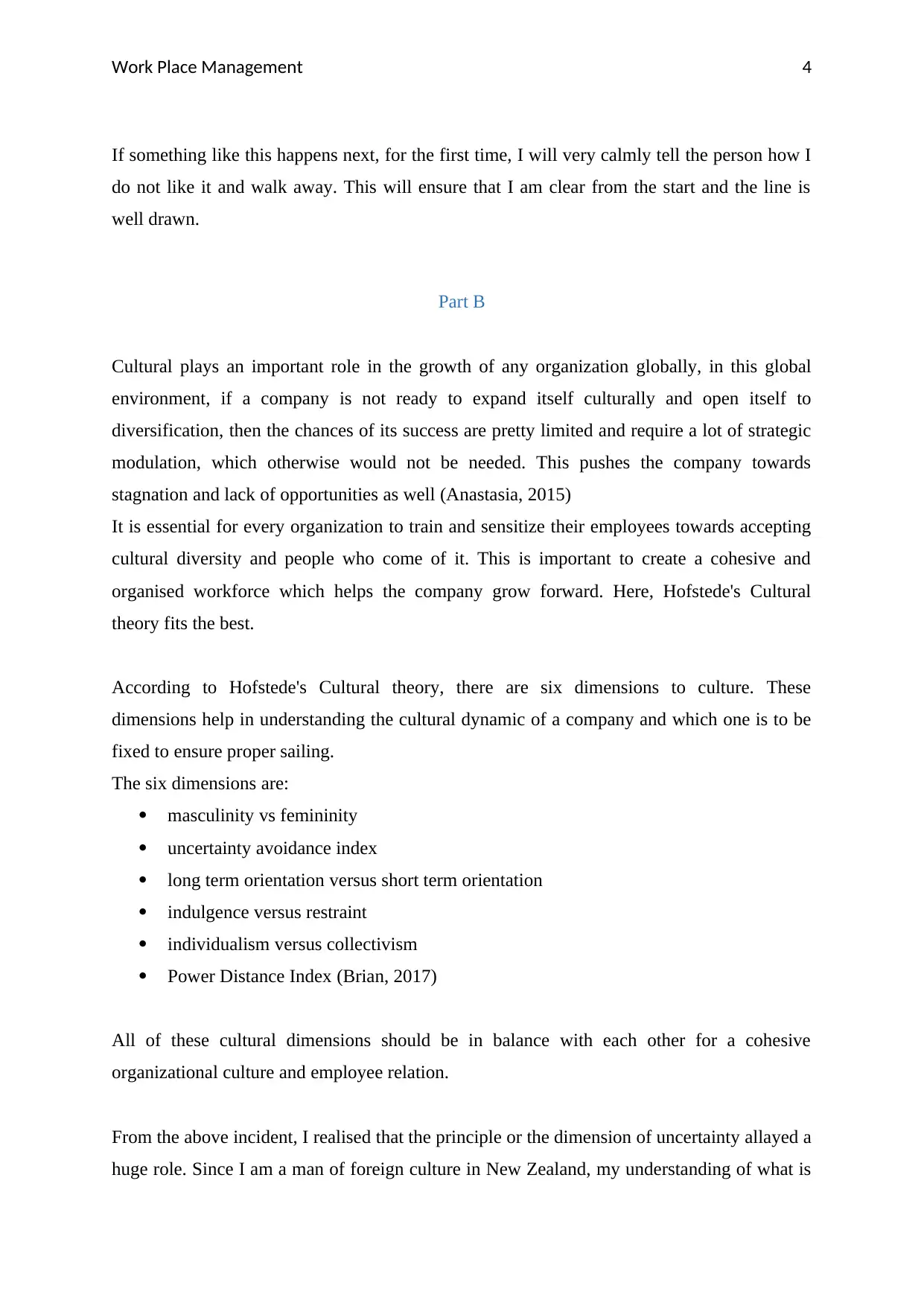Workplace Management: Incident Analysis and Cultural Impact - AMGW700
VerifiedAdded on 2023/01/16
|6
|1485
|54
Report
AI Summary
This report presents an analysis of a workplace incident, exploring the impact of cultural differences and misunderstandings. The report begins with a description of a personal experience involving a conflict with a coworker stemming from a culturally insensitive joke. It then delves into the importance of cultural awareness and sensitivity in the workplace, utilizing Hofstede's cultural dimensions to explain the underlying causes of the incident. The report emphasizes the significance of understanding and respecting cultural diversity to foster a cohesive work environment. Furthermore, it discusses the Treaty of Waitangi, its principles, and its role in promoting equality and inclusion within the New Zealand workplace. The report concludes by highlighting the steps taken by Ara Institute of Canterbury to implement the Treaty and create an inclusive environment. The report provides references to support the arguments made.

Work Place Management
Work Place Management
Student Name:
Institute Name:
1
Work Place Management
Student Name:
Institute Name:
1
Paraphrase This Document
Need a fresh take? Get an instant paraphrase of this document with our AI Paraphraser

Work Place Management
Table of Contents
Part A........................................................................................................................................3
Part B........................................................................................................................................4
PART C.....................................................................................................................................5
2
Table of Contents
Part A........................................................................................................................................3
Part B........................................................................................................................................4
PART C.....................................................................................................................................5
2

Work Place Management
Part A
This part covers a specific incident involving me and a fellow worker. The incident happened
at my workplace in Westfield mall Riccarton, where I work as a cleaner. I am usually always
well-spoken and kind to my co-workers and I stay away from regular gossip session or
meddling with someone in their personal lives as well.
While I am not particularly outgoing or overfriendly with my co-workers, I enjoy a good and
decent relationship with all of them in general.
The incident occurred during our lunch break while we all were resting and eating. This is the
time when we talk and make fun of each other to blow the steam off. However, during this
process, one of my co-workers stepped the line a little too much. Here, I found the words
uttered not funny and rather racist. Owing to this I lost my cool and we got into a fight.
However, my other friends explained to me that his intention was pure of having fun and
nothing more than that. They also told me that this is something which is accepted in New
Zealand and nobody usually takes offence over such remarks.
While I cooled off and apologised, I still did not feel it was right of that person to make jokes
over my skin colour and my country of origin. I felt that people should not take these things
lightly or support other people when they do it. When I sit to analyse this experience, I
realised that no part of it was actually good. It was extremely bad for me and I felt
uncomfortable for a long time. While I understood that the way we joke is different from
country to country, I also understood that it is important to draw a line so as to avoid any
inconvenience later on. The situation did not make any sense to me. I realised that people
have forgotten basic courtesy and do not realise that certain jokes can often not go down in
good humour and especially at times when discrimination is one rise all around the world.
The only difference, which I feel could have been made to the outcome is if I had acted a
little more tolerant from the start and did not get so worked-up immediately. This way, I feel
the relationship would not have gotten awkward. From this incident, I understood one thing
very clearly that not all people will be sensitive, but that does not mean that they gave poor
intentions. However, one should draw the line from the start and ensure that people are aware
of what is okay and what is not. This way, things to do not sour up later and things remain
cordial as well.
3
Part A
This part covers a specific incident involving me and a fellow worker. The incident happened
at my workplace in Westfield mall Riccarton, where I work as a cleaner. I am usually always
well-spoken and kind to my co-workers and I stay away from regular gossip session or
meddling with someone in their personal lives as well.
While I am not particularly outgoing or overfriendly with my co-workers, I enjoy a good and
decent relationship with all of them in general.
The incident occurred during our lunch break while we all were resting and eating. This is the
time when we talk and make fun of each other to blow the steam off. However, during this
process, one of my co-workers stepped the line a little too much. Here, I found the words
uttered not funny and rather racist. Owing to this I lost my cool and we got into a fight.
However, my other friends explained to me that his intention was pure of having fun and
nothing more than that. They also told me that this is something which is accepted in New
Zealand and nobody usually takes offence over such remarks.
While I cooled off and apologised, I still did not feel it was right of that person to make jokes
over my skin colour and my country of origin. I felt that people should not take these things
lightly or support other people when they do it. When I sit to analyse this experience, I
realised that no part of it was actually good. It was extremely bad for me and I felt
uncomfortable for a long time. While I understood that the way we joke is different from
country to country, I also understood that it is important to draw a line so as to avoid any
inconvenience later on. The situation did not make any sense to me. I realised that people
have forgotten basic courtesy and do not realise that certain jokes can often not go down in
good humour and especially at times when discrimination is one rise all around the world.
The only difference, which I feel could have been made to the outcome is if I had acted a
little more tolerant from the start and did not get so worked-up immediately. This way, I feel
the relationship would not have gotten awkward. From this incident, I understood one thing
very clearly that not all people will be sensitive, but that does not mean that they gave poor
intentions. However, one should draw the line from the start and ensure that people are aware
of what is okay and what is not. This way, things to do not sour up later and things remain
cordial as well.
3
⊘ This is a preview!⊘
Do you want full access?
Subscribe today to unlock all pages.

Trusted by 1+ million students worldwide

Work Place Management
If something like this happens next, for the first time, I will very calmly tell the person how I
do not like it and walk away. This will ensure that I am clear from the start and the line is
well drawn.
Part B
Cultural plays an important role in the growth of any organization globally, in this global
environment, if a company is not ready to expand itself culturally and open itself to
diversification, then the chances of its success are pretty limited and require a lot of strategic
modulation, which otherwise would not be needed. This pushes the company towards
stagnation and lack of opportunities as well (Anastasia, 2015)
It is essential for every organization to train and sensitize their employees towards accepting
cultural diversity and people who come of it. This is important to create a cohesive and
organised workforce which helps the company grow forward. Here, Hofstede's Cultural
theory fits the best.
According to Hofstede's Cultural theory, there are six dimensions to culture. These
dimensions help in understanding the cultural dynamic of a company and which one is to be
fixed to ensure proper sailing.
The six dimensions are:
masculinity vs femininity
uncertainty avoidance index
long term orientation versus short term orientation
indulgence versus restraint
individualism versus collectivism
Power Distance Index (Brian, 2017)
All of these cultural dimensions should be in balance with each other for a cohesive
organizational culture and employee relation.
From the above incident, I realised that the principle or the dimension of uncertainty allayed a
huge role. Since I am a man of foreign culture in New Zealand, my understanding of what is
4
If something like this happens next, for the first time, I will very calmly tell the person how I
do not like it and walk away. This will ensure that I am clear from the start and the line is
well drawn.
Part B
Cultural plays an important role in the growth of any organization globally, in this global
environment, if a company is not ready to expand itself culturally and open itself to
diversification, then the chances of its success are pretty limited and require a lot of strategic
modulation, which otherwise would not be needed. This pushes the company towards
stagnation and lack of opportunities as well (Anastasia, 2015)
It is essential for every organization to train and sensitize their employees towards accepting
cultural diversity and people who come of it. This is important to create a cohesive and
organised workforce which helps the company grow forward. Here, Hofstede's Cultural
theory fits the best.
According to Hofstede's Cultural theory, there are six dimensions to culture. These
dimensions help in understanding the cultural dynamic of a company and which one is to be
fixed to ensure proper sailing.
The six dimensions are:
masculinity vs femininity
uncertainty avoidance index
long term orientation versus short term orientation
indulgence versus restraint
individualism versus collectivism
Power Distance Index (Brian, 2017)
All of these cultural dimensions should be in balance with each other for a cohesive
organizational culture and employee relation.
From the above incident, I realised that the principle or the dimension of uncertainty allayed a
huge role. Since I am a man of foreign culture in New Zealand, my understanding of what is
4
Paraphrase This Document
Need a fresh take? Get an instant paraphrase of this document with our AI Paraphraser

Work Place Management
right and what is not according to that of New Zealand culture is pretty limited. Owing to
this, I am always uncertain about things and how I am supposed to act and react to a situation.
If there are no people to guide me, I often find myself moving away or simply declining to be
a part of the situation entirely. This dimension has affected a lot of people who face cultural
issues at their workplace, and it has become increasingly important for companies to take
note of this situation as soon as possible.
I also understood from the above-mentioned situation, that it was because of this factor of
uncertainty and my unawareness or rather lack of awareness about cultural distance between
both the places that I let the situation affect my judgement and something that could have
been solved just so easily went out of hand so much that people had to intervene and explain
to me the situation clearly (Luo, 2016).
It is quite clear that organizations should focus on welcoming the people who are culturally
diverse in ways to make them aware of cultural appropriation and also sensitise the existing
people of the organization towards understanding the issues the newcomers face and how
they can help the people and not make them feel uncomfortable for no reason.
PART C
The treaty of Waitangi is one of the most important treaties of the independent New Zealand
which gave the Maori community the right of equality and sustenance. The treaty protects the
ingenious tribe and aims towards their proper inclusions in the mainstream New Zealand life
to ensure that the people do not lack anything which they are entitled to, right from basic
amenities to voting rights (NZ Herald, 2017).
The treaty of Waitangi has been built on three principles:
Partnership
Protection
Participation
The treaty aims to bring together all the people from the Maori community in the mainstream
to ensure that the Maori are given equal considerations and decision making for all the areas
pertaining to their fields of jurisdiction such as their land, resources and tribe to name a few.
5
right and what is not according to that of New Zealand culture is pretty limited. Owing to
this, I am always uncertain about things and how I am supposed to act and react to a situation.
If there are no people to guide me, I often find myself moving away or simply declining to be
a part of the situation entirely. This dimension has affected a lot of people who face cultural
issues at their workplace, and it has become increasingly important for companies to take
note of this situation as soon as possible.
I also understood from the above-mentioned situation, that it was because of this factor of
uncertainty and my unawareness or rather lack of awareness about cultural distance between
both the places that I let the situation affect my judgement and something that could have
been solved just so easily went out of hand so much that people had to intervene and explain
to me the situation clearly (Luo, 2016).
It is quite clear that organizations should focus on welcoming the people who are culturally
diverse in ways to make them aware of cultural appropriation and also sensitise the existing
people of the organization towards understanding the issues the newcomers face and how
they can help the people and not make them feel uncomfortable for no reason.
PART C
The treaty of Waitangi is one of the most important treaties of the independent New Zealand
which gave the Maori community the right of equality and sustenance. The treaty protects the
ingenious tribe and aims towards their proper inclusions in the mainstream New Zealand life
to ensure that the people do not lack anything which they are entitled to, right from basic
amenities to voting rights (NZ Herald, 2017).
The treaty of Waitangi has been built on three principles:
Partnership
Protection
Participation
The treaty aims to bring together all the people from the Maori community in the mainstream
to ensure that the Maori are given equal considerations and decision making for all the areas
pertaining to their fields of jurisdiction such as their land, resources and tribe to name a few.
5

Work Place Management
This treaty has ensured that the Maori people are not discriminated on the basis of anything
and enjoy equality (HRNZ, 2019). This has also ensured that people from different cultures
are also treated respectably and enjoy proper considerations in the workplace to the best of
their possibilities and capabilities.
Ara plays an essential role in acknowledging and implementing the Treaty of Waitangi to
ensure that the people work in an all-inclusive environment. Ara as an instrument has taken
several steps to ensure that it implements the treaty in the best possible manner. for example,
ARA has led out a framework to ensure maximum Maori participation in workforce by
ensuring skill development for the people. Second such example, is, Ara has promoted
partnership between various organizations and the Maori community, again, to boos their
involvement in the workforce.
References
Brian, M. (2017). Hofstede's Cultural Dimensions. Retrieved from
https://www.mindtools.com/pages/article/newLDR_66.htm
Anastasia. (2015). Understanding Cultures & People with Hofstede Dimensions. Retrieved
from https://www.cleverism.com/understanding-cultures-people-hofstede-dimensions/
Luo, Y. (2016). Competing in the complex cross-cultural world: Philosophical insights from
Yin-Yang. CROSS-CULTURAL & STRATEGIC MANAGEMENT, 23(2).
NZ Herald. (2017). Why the Treaty of Waitangi matters. Retrieved from
https://www.nzherald.co.nz/nz/news/article.cfm?c_id=1&objectid=11794425
HRNZ. (2019). Treaty of Waitangi. Retrieved from
https://www.hrinz.org.nz/Site/Resources/Knowledge_Base/Q-Z/Treaty_of_Waitangai.
aspx
6
This treaty has ensured that the Maori people are not discriminated on the basis of anything
and enjoy equality (HRNZ, 2019). This has also ensured that people from different cultures
are also treated respectably and enjoy proper considerations in the workplace to the best of
their possibilities and capabilities.
Ara plays an essential role in acknowledging and implementing the Treaty of Waitangi to
ensure that the people work in an all-inclusive environment. Ara as an instrument has taken
several steps to ensure that it implements the treaty in the best possible manner. for example,
ARA has led out a framework to ensure maximum Maori participation in workforce by
ensuring skill development for the people. Second such example, is, Ara has promoted
partnership between various organizations and the Maori community, again, to boos their
involvement in the workforce.
References
Brian, M. (2017). Hofstede's Cultural Dimensions. Retrieved from
https://www.mindtools.com/pages/article/newLDR_66.htm
Anastasia. (2015). Understanding Cultures & People with Hofstede Dimensions. Retrieved
from https://www.cleverism.com/understanding-cultures-people-hofstede-dimensions/
Luo, Y. (2016). Competing in the complex cross-cultural world: Philosophical insights from
Yin-Yang. CROSS-CULTURAL & STRATEGIC MANAGEMENT, 23(2).
NZ Herald. (2017). Why the Treaty of Waitangi matters. Retrieved from
https://www.nzherald.co.nz/nz/news/article.cfm?c_id=1&objectid=11794425
HRNZ. (2019). Treaty of Waitangi. Retrieved from
https://www.hrinz.org.nz/Site/Resources/Knowledge_Base/Q-Z/Treaty_of_Waitangai.
aspx
6
⊘ This is a preview!⊘
Do you want full access?
Subscribe today to unlock all pages.

Trusted by 1+ million students worldwide
1 out of 6
Related Documents
Your All-in-One AI-Powered Toolkit for Academic Success.
+13062052269
info@desklib.com
Available 24*7 on WhatsApp / Email
![[object Object]](/_next/static/media/star-bottom.7253800d.svg)
Unlock your academic potential
Copyright © 2020–2025 A2Z Services. All Rights Reserved. Developed and managed by ZUCOL.




